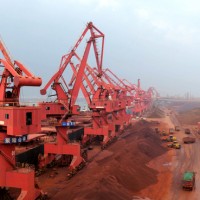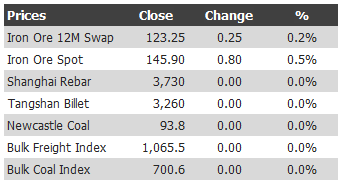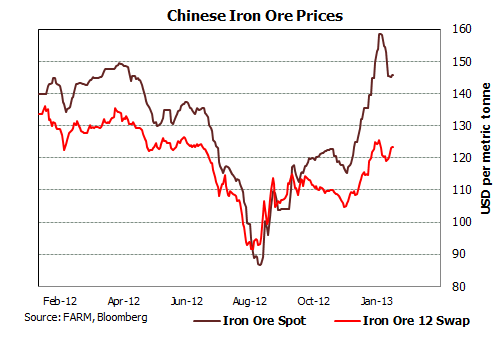
Find below the iron ore price complex table for January 21, 2013:

And the chart:

The big news overnight is that Indian ore continues to slide down the top exporters list. From Reuters:
South Africa overtook India to become China’s third-biggest iron ore supplier in 2012, while Australia strengthened its dominant position as the major supplier to the world’s biggest iron ore consuming nation, data from customs showed on Monday.
South Africa provided 40.6 million tonnes over the year, up 12 percent compared to 2011, while Indian imports declined 54.74 percent to 33 million tonnes.
Indian authorities have been cracking down on chaotic and illegal iron ore production, with the state of Goa — one of the country’s biggest suppliers — imposing a blanket ban on all mining activities last October.
Supplies from India amounted to 10.6 percent of China’s total imports in 2011, but were already disrupted by a mining ban in Karnataka, India’s biggest iron ore producing state.
…”This year should be the year of Australia taking an increasing market share on the global iron ore market,” said Graeme Train, commodities analyst with Macquarie in Shanghai.
“Brazil is not going to see any growth with Vale guiding for negative volumes — the vast majority of growth on the seaborne market is coming from Australia.”
…Supplies from India are not expected to recover in the near term, and are unlikely to reach previous high levels, said Train.
“I think India can recover to some extent — they are going through a process of cleaning up illegal operations and eventually it will get back on line, but it will be at severely reduced volumes relative to where they were historically.”
All true and the principal supply-side reason behind my sticky iron ore price thesis for the first half. Hat’s off to Train, who picked this better than most (if not all). But look beyond 2013 and the supply story changes. The FT sums it up nicely:
…Anglo American’s Minas-Rio project in Brazil could start production in 2015. And Vale of Brazil’s Serra Sul mine could follow in 2018. The scale of Brazilian production is bound to depress the ore price. No wonder Rio, which derives about three-quarters of earnings before interest and tax from iron ore, is so keen to bring its Oyu Tolgoi copper mine in Mongolia to fruition.
But the Pilbara’s dominance looks assured in the long run by dint of its proximity to China. Rio’s cash cost is $24.50 a tonne. Add royalties, sustaining capex and $7/t shipping costs, and Rio is landing ore in China at $47/t. Anglo expects to land its ore from Brazil at $55/t to $60/t. With a spot price of about $145/t, Anglo, BHP Billiton, Rio and Vale are sitting pretty. With its fragmented industry and lower grades, China lacks the global miners’ economies of scale, and so will continue to import ore.
Until then it’s all about Australian and some African expansion. But the long term will see iron ore return permanently to prices well under $100. $80 is my target, which will more than offset Australia’s volume expansion, meaning the contribution of iron ore to Australian economic growth is all but over.
Not much more to add on a quiet day except to say that the national media seems finally to have figured out just how important iron ore is to the economy with a new report by Mornigstar, which said absolutely nothing new, but basked in national headlines. From the Herald Sun:
Iron ore is overvalued and the spot price will continue to slide after easing over the past week, a new report says.
Morningstar is tipping the price of iron ore to fall to $US130 a tonne in the short term and flatten to $US90 a tonne by 2015…
Ah…the thankless life of the blogger!

